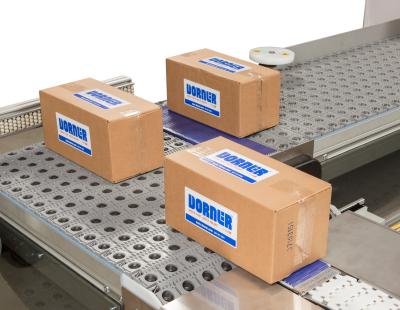
Dorner says the new 3200 series conveyor with Intralox Activated Roller Belt (ARB) technology is perfect for moving boxes and packages in merging, diverting and aligning applications. ARB Technology uses low and high friction angled rollers within the belt to help smoothly guide and align items of all sizes. This conveyor technology minimizes floor space, increases system reliability, eliminates costly system controls, provides a safer work environment, and can handle products as small as 6” x 6”.
For specific applications, ARB technology works well for:
• 90° transfers maintaining product orientation
• Aligners/edge justification
• Case turners
• Bump turns
• Touchless low friction mergers
• Rejects
90° Transfers and Lane Merges
• 90° Passive On and 90° Passive Off transfers
• No adjustment needed for different size products
• Requires 6”–8” gap upstream
• 90° Passive On requires some product momentum, 90° Passive Off does not
• Using Passive On, product can merge into a gap on the mainline ARB conveyor
• Uses Series 400 45° chain and passive rollers
Edge Justification and Bump Turns
• No adjustment needed for different size products
• Edge justification requires no product gap
• Bump turn needs 6”–8” gap upstream
• A fixed or pneumatically controlled protrusion from the side rail is added to help start the turning process
• Uses Series 400 30° chain and activated rollers
Contact Details
Related Glossary Terms
- turning
turning
Workpiece is held in a chuck, mounted on a face plate or secured between centers and rotated while a cutting tool, normally a single-point tool, is fed into it along its periphery or across its end or face. Takes the form of straight turning (cutting along the periphery of the workpiece); taper turning (creating a taper); step turning (turning different-size diameters on the same work); chamfering (beveling an edge or shoulder); facing (cutting on an end); turning threads (usually external but can be internal); roughing (high-volume metal removal); and finishing (final light cuts). Performed on lathes, turning centers, chucking machines, automatic screw machines and similar machines.
